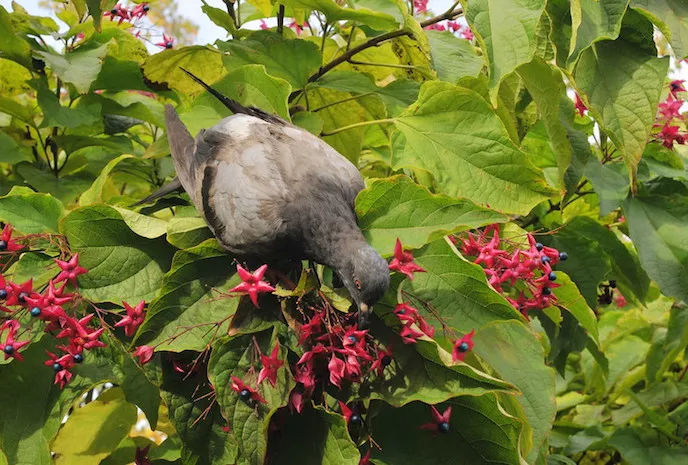Cascades of delicate but showy flowers are the calling card of this otherwise unremarkable deciduous shrub. Its scientific name Clerodendrum trichotomum comes from the Greek words "kleros" which means chance or destiny, and "dendron" meaning tree, leading to one of the plant's slightly less common names "fate tree." As its elaborate common name suggests, harlequin glorybower was introduced to the western world during the Victorian era, collected from Japan by the Russian botanist Karl Maximovich during one of his Far East expeditions in the 1860s.
The common name "peanut butter bush" refers to the unusual (and rather unpleasant) scent emitted by the leaves when they are crushed. The flowers, however, have a lovely sweet fragrance similar to summersweet, another pollinator-friendly shrub which blooms at the same time. Harlequin glorybower is sometimes known as "bleeding heart vine" due to its bright red calyxes, but this name is more commonly used to refer to its close relative Clerodendrum thomsoniae.
Botanical Name:
Clerodendrum trichotomum
Common Name:
Harlequin Glorybower, peanut butter bush, fate tree, glory tree
Plant Type:
Deciduous shrub
Mature Size:
10 to 15 feet
Sun Exposure:
Full sun to partial shade
Soil Type:
Rich, well-drained
Soil pH:
4.6 to 5.0 (acidic)
Bloom Time:
Mid to late summer
Flower Color:
White, showy deep pink calyx
Hardiness Zones:
6b to 11
Native Areas:
China, Korea, Taiwan, Japan, and India

How to Grow Harlequin Glorybower
This shrub puts on quite a performance through the season, with white flowers emerging from a green calyx in early summer; the calyx then turns deep pink to red as the flowers drop off and bright blue berries emerge, attracting a variety of birds. The blue color is from a naturally-occurring pigment called trichtomine, giving this plant its full botanical name. The leaves tend to die back with the first hard frost, but the colorful calyx and berries remain.
Light
Harlequin glorybower does best with full sun, but in hotter zones, some afternoon shade might be advisable to keep the flowers from wilting too fast in mid summer. At least six hours of direct sunlight brings out bigger flowers and berries.
Soil
This plant likes a rich, loamy, slightly sandy, well-drained soil. Persistently soggy soil can cause root rot or other damage, so choose the planting location well.
Water
These shrubs are fairly drought tolerant and should not need extra watering, unless there is an unusually dry spring or summer, in which case it may benefit from irrigation.
Temperature and Humidity
Since these plants are not super cold-hardy, early or late frost can affect their growth cycle: a late spring frost may kill flower buds that have already emerged, so cover them if this occurs. Early frost in autumn, however, will merely cause the green leaves to wither and drop off and not otherwise harm the plant. The cooler your growing zone, the more aggressively this plant will put out suckers that will need to be firmly controlled by pruning.
Fertilizer
You may find that your glorybower benefits from a light application of water-soluble fertilizer in spring to promote more abundant flower blooms and berries. Stop fertilizing once the flowering period is over.
Planting and Maintenance
These ornamental flowering shrubs like to grow in tropical areas but some newer cultivars such as 'Betty Stiles' are hardy to Zone 6b, meaning they can flourish as far North as New York City and the lower Hudson Valley. It grows profusely, and sometimes somewhat aggressively. It puts out many suckers which should be removed every season, in spring or fall, to temper its invasive tendencies. In order to achieve this plant's colorful show of berries, it is necessary to plant two clones to achieve fertilization and fruit set. Usually glorybower is grown as a shrub but it is possible to train it as a tree form with careful and consistent pruning. In colder regions, it is also possible to cut this plant to the ground each winter to control growth and spread.
Propagating Harlequin Glorybower
This plant may be propagated by root cuttings or semi-hardwood cuttings in spring.
Pollinators and Pests
Glorybower is not toxic to humans or animals, and is virtually disease and pest-free. The flowers, which are rich with nectar, attract bees, moths, hummingbirds and butterflies, and the berries attract many birds, so it is a useful wildlife food plant to have in your garden.